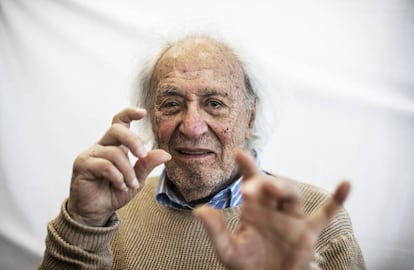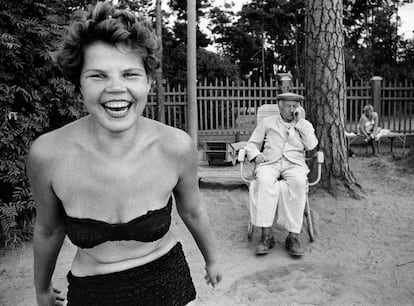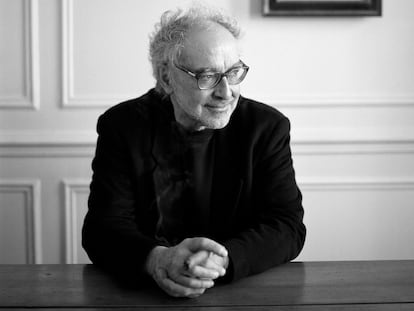William Klein, master of urban photography, dies at 96
A good photograph should express feelings, the US-born, French-based artist used to say about work that captured the dynamics of cities around the world

The great American photographer William Klein has died in Paris at the age of 96. The death occurred on September 10 but was not made public until two days later. He passed away “peacefully,” according to his son Pierre Klein.
One of the world’s most celebrated artists, he was credited with revolutionizing photography, achieving iconic status with his groundbreaking book Life is Good and Good for You in New York (1956).
“I had the feeling at that moment that New York City was exploding in front of me and that all these people, this movement, was coming at me. I could see that I could use it to photograph because it conveyed emotions, feelings. For me, everything is about feelings,” he said on his last trip to Madrid, in 2019, for the presentation of a retrospective of his work. “Today people are very used to being photographed in the street. However, when I was doing it, they were surprised that I was there and that I stuck so close to them. Their emotions inspired me. At the same time, I was planning, I had my ideas, I had it all in my head – how I was going to lay it out, to prepare everything; I had a picture of the whole thing.”
The son of Orthodox Jewish immigrants, Klein was born in New York in April 1926 and joined the US army during World War II, getting posted first to Germany, then to France. In 1947, he settled in Paris and enrolled at the Sorbonne University. With cubist painter Fernand Léger as his teacher, his first impulse was to be a painter, but he soon turned to photography, specializing in fashion for Vogue, and finally making a name for himself in the world of photojournalism. This undoubtedly explains the eclecticism of his work that went from abstract paintings to a passion for filmmaking – between documentaries, short and full-length features, he directed around 20 films as well as making 250 commercials.

While in Paris, Klein studied the masters of the Renaissance, as well as Mondrian and the architects of the 20th century. “I shot at random, without aim, exaggerating the grain, the contrast; I enlarged excessively and, in general, put the photographic process through the blender,” he said of that time. With his “European vision and native American instinct,” as he put it, he later photographed Rome (1958), Moscow (1964) and Tokyo (1964).

Thanks to his talent and his hunting instincts, he was able to pick out people in the crowd and portray them not just as individuals but as the very society they lived in. As a result, his New York was as varied as it was optimistic.
When working as a fashion photographer, he employed a different, if equally striking, language, becoming the first to take models out of the studio and into the street to mingle with the crowds.
Klein shot in spurts, with a wide-angle lens on his camera that zoomed in on his subjects. In doing so, he moved away from the traditional forms of French photographer Cartier Bresson, opting for a more expressionistic, streetwise style. “The most beautiful and unique thing about people is their gaze,” he said in a 2005 interview with EL PAÍS. “In New York people don’t look you in the eye because it can get you in trouble. When I was a kid walking around a neighborhood that wasn’t mine – which felt like traveling round a foreign country – people would get upset if you looked at them. I found several ways to deal with that. One was tobacco. I would ask for a light and distract their attention that way. Another was to play dumb. You avoid fights – it always works.”
Tu suscripción se está usando en otro dispositivo
¿Quieres añadir otro usuario a tu suscripción?
Si continúas leyendo en este dispositivo, no se podrá leer en el otro.
FlechaTu suscripción se está usando en otro dispositivo y solo puedes acceder a EL PAÍS desde un dispositivo a la vez.
Si quieres compartir tu cuenta, cambia tu suscripción a la modalidad Premium, así podrás añadir otro usuario. Cada uno accederá con su propia cuenta de email, lo que os permitirá personalizar vuestra experiencia en EL PAÍS.
¿Tienes una suscripción de empresa? Accede aquí para contratar más cuentas.
En el caso de no saber quién está usando tu cuenta, te recomendamos cambiar tu contraseña aquí.
Si decides continuar compartiendo tu cuenta, este mensaje se mostrará en tu dispositivo y en el de la otra persona que está usando tu cuenta de forma indefinida, afectando a tu experiencia de lectura. Puedes consultar aquí los términos y condiciones de la suscripción digital.
More information
Últimas noticias
Maduro pleads not guilty before the federal court in New York: ‘I am still the president of Venezuela’
A new test can detect Alzheimer’s from a finger prick
UN team enters Sudanese city of El Fasher after paramilitary massacre: ‘It’s like a ghost town’
A recipe for resistance: Indigenous peoples politicize their struggles from the kitchen
Most viewed
- Gilles Lipovetsky: ‘If you want to live better and fall in love, take Prozac, don’t look to philosophy’
- Alain Aspect, Nobel laureate in physics: ‘Einstein was so smart that he would have had to recognize quantum entanglement’
- Alvin Hellerstein, a 92-year-old judge appointed by Bill Clinton, to preside over Maduro’s trial in New York
- Why oil has been at the center of Venezuela-US conflicts for decades
- Cuba confirms death of 32 of its citizens in the US attack against Venezuela










































